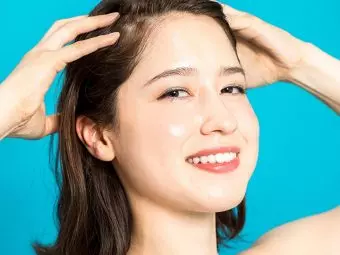Thin, wispy baby hairs crowning your hairline can be difficult to style and manage. Sometimes, making them lie flat can be a hassle. They always end up unruly, sticking out, and stubborn to style.
Baby hair strands have a different texture than the rest of your locks. Maintaining and styling them requires dedication. However, once you master the art of styling them, your hair will look spectacular! Keep reading to learn how you can style and care for your baby hair or remove it if you want.
In This Article
What Are Baby Hairs? Is It True That They Do Not Grow Much?
Baby hairs are short, wispy, and thin hairs that sit around the hairline. The baby hairs around the edges are known as vellus hair and are different from terminal hair that grows on the scalp. Vellus or baby hairs have the same growth pattern as regular scalp hair, and they go through a normal hair cycle. However, the hair cycle phases of vellus hair are shorter than the phases of terminal hair.
Like terminal hair, vellus hair grows from the hair follicle that contains sebaceous glands. However, the glands of vellus hair are not as active as the glands in terminal hair follicles. Due to all these factors, vellus hair does not grow beyond a certain length (2 mm).
Baby hairs are not likely to cause any trouble unless you try to fashion them to match your hairstyle. Vellus or baby hairs form the hairline or the “edges” in adults. They are seen around the hairline, above the ears, and at the nape. If you wonder why adults get baby hairs, scroll through the next section.
The Causes Of Baby Hairs
Adults get baby hair due to a short anagen (hair growth) phase. During the anagen phase, the hair starts to grow. With a short anagen phase, the baby hair cannot grow as long as the terminal hair and cover the scalp. This can happen over several hair growth cycles.
However, sometimes, baby hairs are confused with short hair strands caused by breakage. There is a difference between the two. In the next section, find out how to identify breakage and regular baby hair.
How To Differentiate Between Baby Hairs And Hair Breakage
You may experience baby hair-like breakage close to the hairline. Continuous traction, tight hairstyles, excessive heat, and chemical damage causes hair breakage close to the hairline. The broken and damaged hair strands appear shorter than the rest of the terminal hair and may stick up.
Here are a few tips to differentiate between baby hair and breakage:
- Damaged hair appears dry and may have split ends.
- If you notice more than usual baby hairs on the hairline, this could be a case of hair breakage.
- Pull up your hair in a tight ponytail. Lift all the short hair strands and observe them. If they are longer than the baby hair strands and sit close to the scalp than the hairline, they are the damaged strands.
You will need to bring your hairstyling techniques under control. Try a change in your usual hairstyle or look out for newer and friendlier hairstyles that do not pull down on your hair as much. This can help you avoid any hair breakage around the hairline.
If you have damaged strands, you need to check your hairstyling routine. Avoid using excessive heat and chemical hairstyling products to prevent hair damage. Managing and styling baby hair can be tough due to the texture difference. Follow these tips to make the baby hair a part of your hairstyling routine.
How To Style Baby Hairs
- If the baby hairs are sticking up, tie your hair in a loose bun or ponytail for a natural look, and to hide them.
- Spritz some hairspray on a toothbrush and spread it lightly over the baby hairs. Lay it in the direction of their growth.
- Use hair gel or hair wax and comb them down.
- Blow dry the baby hairs in a specific direction while drying your hair. This will make the baby strands appear less fuzzy.
- Part your front hair and pin it up in a way to cover the hairline and the baby hairs. Secure the section(s) with bobby pins.
Managing baby hairs can be tough but not impossible if you use the right tools and styling techniques. However, if you do not want baby hairs, you can remove them.
How To Get Rid Of Baby Hairs
You may consider options like:
- Waxing the hairline and nape
- Laser hair removal (you may need multiple sessions and make the strands fine and less noticeable)
- Cut the edges
However, think twice before removing your baby hairs. Kim Kardashian lasered off her baby hairs and now considers it one of her biggest beauty regrets. Hence, talk to a trichologist before removal.
Baby hairs are thin, wispy hairs that sit around your hairline. A short anagen (hair growth) phase is the main cause of baby hairs. As they have a different texture, styling these short hair strands is tough. But using the right tools and techniques can help you manage them. Using a hair gel or hair wax, blow-drying the baby hairs, and using hair spray hairs may help you manage your baby hairs. If you want to get rid of these hairs, try to wax the hairline, cut the edges, or consider laser hair removal.
Key Takeaways
- The anagen hair phase is when hair growth occurs, and a short anagen phase creates baby hairs.
- Baby hairs and broken strands may look alike, but the former are usually dry and have split ends.
- You can use a toothbrush and hair wax or gel to style your baby hairs.
- If you would like to get rid of your baby hair, consider laser hair removal, waxing your hairline, or cutting the edges.
Frequently Asked Questions
Are baby hairs a sign of regrowth?
Yes, baby hairs could be a sign of new hair growth, especially if you have hair fall-related issues.
Does everyone have baby hair?
Yes, everyone gets baby hairs. However, they need gentle handling and proper maintenance as the strands are more fragile than terminal hair.
Should I cut baby hairs?
You may if you cannot handle baby hairs. However, it is better to consult a professional hairstylist.
Can I use a hair removal cream to remove baby hairs from my forehead?
No. Hair removal creams contain sodium hydroxide that can damage the hair follicle and possibly cause scarring over time.
Will using a sulfate shampoo affect baby hair?
Yes. Excessive use of sulfate shampoos may damage fragile baby hairs.
Sources
Articles on StyleCraze are backed by verified information from peer-reviewed and academic research papers, reputed organizations, research institutions, and medical associations to ensure accuracy and relevance. Read our editorial policy to learn more.
- Hair growth and rejuvenation: An overview: https://www.researchgate.net/publication/44661841_Hair_growth_and_rejuvenation_An_overview
- Epilation Today: Physiology of the Hair Follicle and Clinical Photo-Epilation: https://www.jidsponline.org/article/S0022-202X(15)52603-1/fulltext
Related
The following two tabs change content below.
- Author
- Reviewer
Ramona Sinha
Ramona is an editor at StyleCraze. Prior to that, she authored over 200 articles on skin and hair care. She… more
Martine Langsam
(IAT, WTS)Martine is a certified trichologist with over 7 years of experience and a California licensed cosmetologist. She is also an… more



 How To Use Jamaican Black Castor Oil For Hair Growth
How To Use Jamaican Black Castor Oil For Hair Growth How To Exfoliate Your Scalp At Home To Clear Excess Oil
How To Exfoliate Your Scalp At Home To Clear Excess Oil How To Apply Oil On Hair: A Step-By-Step Guide
How To Apply Oil On Hair: A Step-By-Step Guide How To Use Coconut Oil For Dry Scalp And Dandruff
How To Use Coconut Oil For Dry Scalp And Dandruff Easy Way To Get The Perfect Twist Out On 4C Natural Hair
Easy Way To Get The Perfect Twist Out On 4C Natural Hair Eyebrow Hair Loss: Causes, Prevention Tips, & DIY Methods
Eyebrow Hair Loss: Causes, Prevention Tips, & DIY Methods Types Of Hair Loss, Causes, Treatments, & Prevention Options
Types Of Hair Loss, Causes, Treatments, & Prevention Options Itchy Scalp And Hair Loss: How To Treat And How To Prevent It
Itchy Scalp And Hair Loss: How To Treat And How To Prevent It What Is Hair Texturizing? How To Take Care Of Texturized Hair?
What Is Hair Texturizing? How To Take Care Of Texturized Hair?